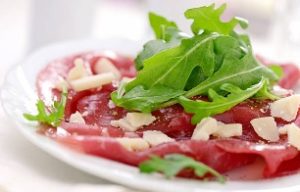A Carpaccio by any other name would be raw beef…

Following my last post of the translations for pasta in Italian, I started looking into food history and origins a little further. One of the anedotes I have heard in passing before is that of the origin of the word Carpaccio. It’s definition is thin slices of raw beef but the word itself does not translate that. So how do an entrée dish come to have such a romantic sounding word? I mean, if you saw a dish called ‘raw sliced beef’ on a menu I am pretty sure you wouldn’t look twice. Call it carpaccio and suddenly you’re intrigued am I right?
My trusty friend Wikipedia has kindly provided this definition:
Carpaccio:
“Carpaccio is the international name of a typical Italian dish made with raw meat. The dish was proposed with this name for the first time in Venice, at the time of an exhibition dedicated to Venetian painter Vittore Carpaccio which took place around 1950.
The dish, based on the Piedmont specialty “carne cruda all’albese”, was invented and popularized by Giuseppe Cipriani, founder of Harry’s Bar in Venice. He originally prepared the dish for the countess Amalia Nani Mocenigo[1] when he learned that the doctors had recommended that she eat raw meat.[2] The dish was named carpaccio after Vittore Carpaccio, the Venetian painter known for the characteristic red and white tones of his work. “
Now Vittore was born in 1460 in Venice, during a time wherein artists had patrons and were revered highly. On closer inspection and investigation it is clear that this artist did indeed have a penchant for red and white tones in his pieces. Quality beef carpaccio is sliced paper thin, usually from the tail end of an eye fillet, the red brilliance of the fresh meat contrasting with the white opaque fat marbled throughout. Seems like a logical connection doesn’t it?
History reveals a long line of dishes named after people, either as the creator of the actual dish or after a notable figure of the time. The most common for Australians would be the pavlova, named after the famous Russian ballerina after her visit to the Southern Hemisphere. Debate still rages over the dish being created in Australia or New Zealand but whatever you believe it is a delicious dessert, contrasting a crunchy and sweet shell with whipped cream and fresh fruit. Either country had the right idea I can tell you.
Not even alcohol can escape the romanticism of naming in a person’s honour. The very delectable Veuve Clicquot is named of the Barbe-Nicolle Ponsardin the widow (translation of ‘veuve’ in French) of Francois Clicquot. Madame turned her husbands house of wool trading, banking and champagne production into the predominantly Champagne, creating a new and novel technique not seen before, creating the delicious drink many celebrate and indulge in today. Thanks again Wikipedia for the help on this one!
Some common ingredients and varieties of food items also pay homage to their creators with Granny Smith owing to the accidental propagation of a new seedling by Marie Ana (Granny) Smith and a staple cooking apple was born.
Delve a little deeper and all sorts of dish reveal themselves. From Pommes Anna, named after 19th-century courtesan/actress Anna Deslions) to those a little more logical, Frangelico from the painter Fra Angelico, it is fascinating walk through the evolution of the dishes that grace restaurant and home dinner tables today.
Do you have a family dish named after someone? A special sauce or dessert that has been passed through each generation?